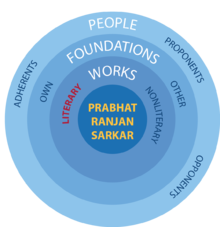Roman Samskrta transliteration
Prabhat Ranjan Sarkar - or Shrii Shrii Anandamurti, his alias for his spiritual works - developed his own Roman Saḿskrta (Sanskrit) transliteration, used as early as 1956, which he asked to be used in all Ananda Marga publications. Doing so, he maintained since then, through all Ananda Marga publications, the presence of reliable Saḿskrta spelling. That transliteration - using only two diacritical marks (' and ^ ( ̭)) - can also easily be typed on an ordinary keyboard still maintaining a good legibility when using its alternative way (see below, in the second table).
The transliteration used by Western Sanskritists is unfortunately not very well adjusted to transliterate Saḿskrta-derived languages, for example, Bengali (or Baḿlá/বাংলা). Sarkar's Roman Saḿskrta may be more apt for that purpose.
The letter ya: the proper Sanskrit pronunciation will be ia in the middle or at the end of a word but will be a light ja in the beginning. According to that, the Bengali script did develop two different letters for those uses: য and য়. য় stands for ia. য stands for the light ja. In line with this and with respect to Roman Baḿlá transliteration, Sarkar accepted one modification to the Roman Saḿskrta transliteration. An initial ya (য) could be replaced by ja, a more common symbol for the sound.[1]
Sarkar's Roman Saḿskrta transliteration: a, á, i, ii, u, ú, r, rr, lr, lrr, e, ae, o, ao, aḿ, ah, ka, kha, ga, gha, uṋa, (velar) ca, cha, ja, jha, iṋa, (palatal) t́a, t́ha, d́a, d́ha, ńa, (retroflex) ta, tha, da, dha, na, (dental) pa, pha, ba, bha, ma, (labial) ya, ra, la, va, (semi vowel) sha, śa, sa, ha, kśa. (sibilant, etc.) ’ is the phonetic elision of initial "a" . ṋ for the candabindu.
Examples: জ্ঞ/ज्ञ: jiṋa (jña); ঋষি/ऋषि: rśi (ṛṣi); ছায়া/छाया: cháyá (chāyā); জ্ঞান/ज्ञान: jiṋána (jñāna); সংস্কৃত/संस्कृत: saḿskrta (saṃskṛta); ততোঽহং/ततोऽहं: tato’haḿ (tato’haṃ); পিঙ্গলা/पिङ्गला: piuṋgalá (piṅgalā).
| Phonetic | Academic | Devanágarii/ Bengali script |
Ánanda Márga | Alternative AM |
|---|---|---|---|---|
| Long a | ā | आ/আ | á | a' |
| Long i | ī | ई/ঈ | ii | |
| Long u | ū | ऊ/ঊ | ú | u' |
| Vowel r/vocalic r | ṛ | ऋ/ঋ | r | |
| Long Vowel r | ṝ | ॠ/ৠ | rr | |
| Vowel l (L) | ḷ | ऌ/ঌ | lr | |
| Long vowel l | ḹ | ॡ/ৡ | lrr | |
| Elongated e diphthong | ai | ऐ/ঐ | ae | |
| Elongated o diphthong | au | औ/ঔ | ao | |
| With velar n | ṅa | ङ/ঙ | uṋa | un^a or (wrongly) una |
| With palatal n | ña | ञ/ঞ | iṋa | in^a or (wrongly) ina |
| With retroflex t | ṭa | ट/ট | t́a | t'a |
| With retroflex d | ḍa | ड/ড | d́a | d'a |
| With retroflex n | ṇa | ण/ণ | ńa | n'a |
| With palatal s | śa | श/শ | sha | |
| With retroflex s | ṣa | ष/ষ | śa | s'a |
| anusvara | aṃ | अं/অং | aḿ | am' |
| visarga | aḥ | अः/অঃ | ah | |
| candrabindu | अँ/অঁ | aṋ | an^ |
Roman Bengali transliteration
For the most part, the Roman Saḿskrta transliteration serves well for Bengali. However, as a living language, Bengali is best served with the addition of some letters, often to accommodate the inclusion of words from other languages. The following recommended additions are not consistently used on Sarkarverse (due to various practical limitations); however, they are recommended by Shrii Sarkar.[2]
| Roman script | Bengali script | Purpose |
|---|---|---|
| ba | ৰ | To distinguish between vargiiya ba and antahstha va |
| qa | ক় | To accommodate words found in Hebrew, Arabic, and Farsi |
| qha | খ় | To accommodate words found in Hebrew, Arabic, and Farsi |
| qua | ক় | To accommodate words found in Hebrew, Arabic, and Farsi |
| za | জ় | To accommodate words found in Hebrew, Arabic, Farsi, English, French, Latin, and most of the Latin-group languages |
| ŕa | ড় | To reflect the actual pronunciation |
| ŕha | ঢ় | To reflect the actual pronunciation |
| t | ৎ | To expedite Bengali script |
| fa | ফ় | To accommodate words found in Hebrew, Arabic, Farsi, English, French, Latin, and most of the Latin-group languages |
| ya | য় | To reflect the actual pronunciation |
| lra | ল় | To accommodate words found in Sanskrit, Marathi, Gujarati, and some South Indian languages as well as some North Indian pronunciation |
| aṋ | অঁ | To accommodate pronunciation of the candrabindu in modern Bengali |
References
- ^ Sarkar, Prabhat Ranjan (1993) Acarya Vijayananda Avadhuta, ed. Prabhat Samgiita Volume 1 Kolkata: Ananda Marga Publications ISBN 81-7252-041-7
- ^ Sarkar, Prabhat Ranjan (1996 first English edit.) Acarya Vijayananda Avadhuta, ed. Shabda Cayanika Part 2 Kolkata: Ananda Marga Publications ISBN 81-7252-102-2
